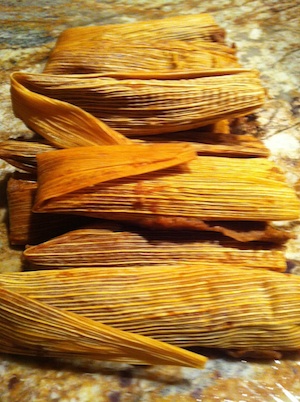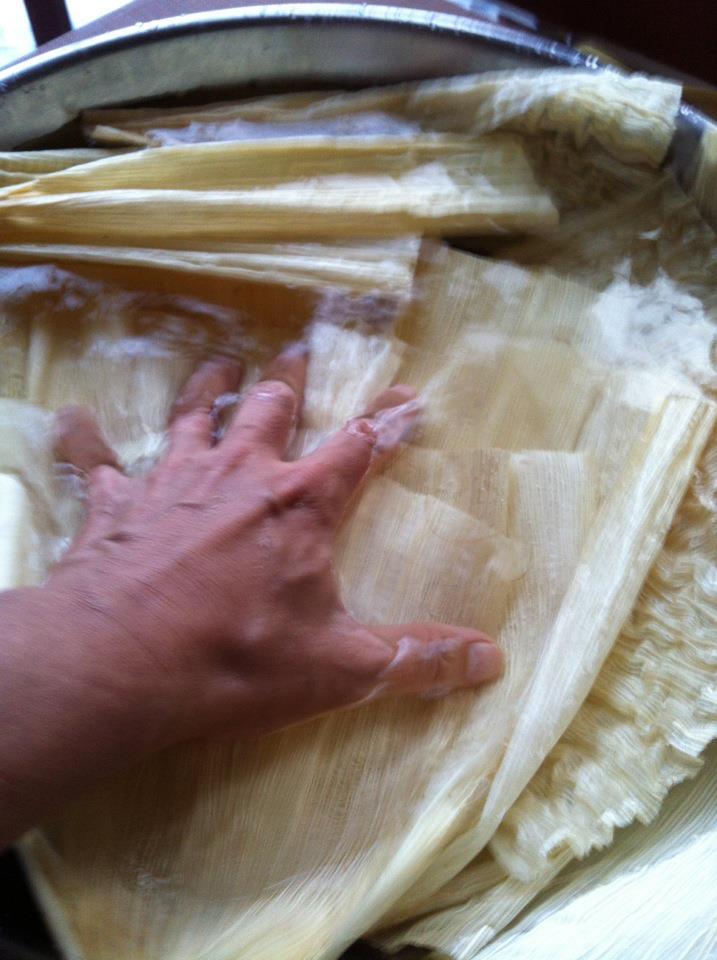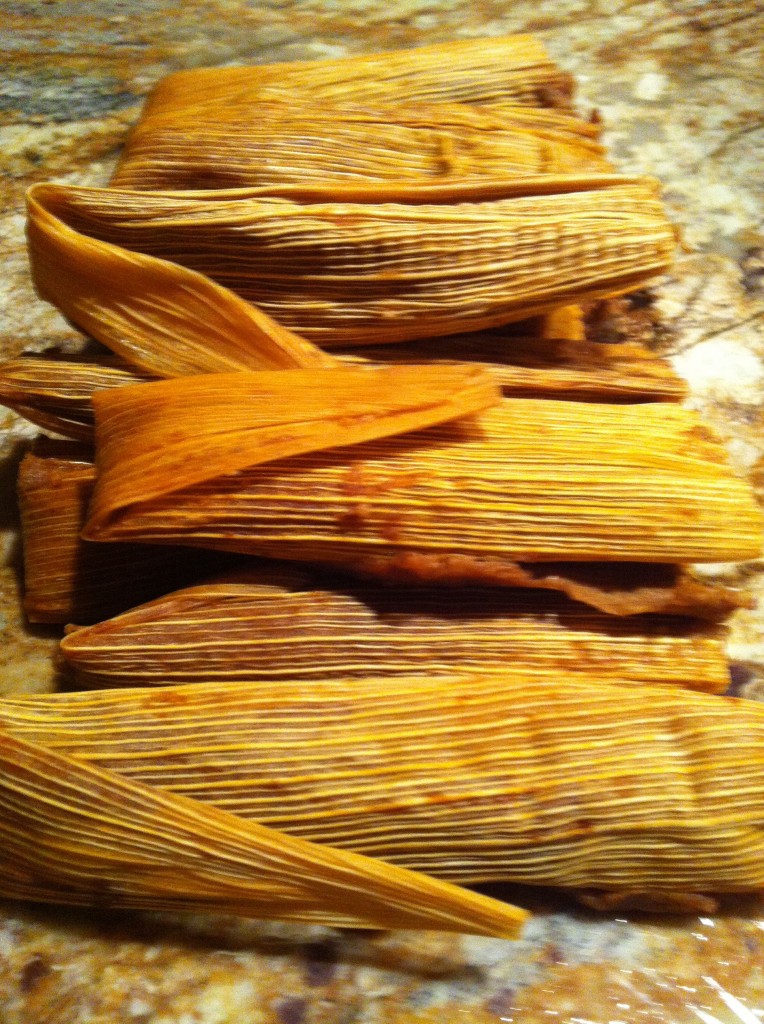Holiday Traditional Bean Tamales

Bean tamales are traditional all the way from Texas to Puebla to Oaxaca and other regions of Mexican cuisine. I love them because historically they pre-date the arrival of European immigrants who after 1528 started importing pigs and thus lard.

All tamales are the occasion for community, family “Tamaladas.” Plan on making bean tamales over the weekend and invite family and friends to your “Tamalada,” that traditional party, a gathering to celebrate food, family, friendships and,,,,shhhhh a little gossip.
Bean tamales are sensuously delicious. We use pinto beans here in Texas, flavored with Guajillo and Chile Ancho. Farther south, in Oaxaca and other regions, they use black beans.

These bean tamales are in every Mexican American home in Texas. Well I can’t make such an absolute statement, but I can say that they were definitely in my home and in every home of my large extended family and neighbors. Even when we went to Nava, Coahuila, 45 miles south of the Rio Grande, our relatives who lived there served Tamales De Frijol.
Bean tamales are also in southern regions, like in Puebla, Mexico. But they are slightly different and, of course, in Puebla they are sometimes served with Mole Poblano which is a truly wonderful combination. We serve ours as is, or with Salsa Ranchera if you really need some additional tang. Either way, your taste buds will will have a holiday celebration.
This recipe is excerpted from my book, Truly Texas Mexican: A Native Culinary Heritage In Recipes page 51.
Recipe for Bean Tamales
(makes one dozen tamales, or up to 16 if you stretch the masa)
Ingredients:
For Masa and Husks:
16 dried tamale husks, Hojas de Maíz, soaked in hot water for at least 30 minutes.
1 lb masa for tamales. This is a coarser grind than masa for tortillas. It is called “masa quebrada.”
1/2 cup Canola oil. I actually use organic palm oil shortening. It works really great and has no transfats, since it is not hydrogenated. Also, as a solid fat it harkens back to pre-1500, before pigs, when we cooked with absolutely no lard anywhere to be seen.
1/4 to 1/2 cup water if needed
For the Chile Paste:
1 garlic clove
3 Chiles Ancho, cleaned, seeded and deveined
3 Guajillo Chiles, cleaned, seeded and deveined
1/2 tsp ground cumin
3/4 cups water
1 Tbsp canola oil
1 tsp salt or to taste
For the Beans:
1/2 lb beans. If you want to, soak the beans overnight so that they will cook more quickly, 1 1/2 hours. If you don’t soak them (I never do) cooking time will be 4 hours.
1 tsp salt
4 cups water
Method
First, place the corn husks in a large container and cover them with hot water. Let them soak and soften for at least 30 minutes and overnight if you like.
For the Beans:
1. Pick over the beans to remove any small stones or debris. Rinse them in a colander.
2.In a large pot, add the beans and salt. Cover the beans with 4 cups of water, bring to a boil, then turn down the heat and simmer, covered. If the beans have been soaked overnight you will cook them for 1 1/2 hours. If they have not been soaked, it will take 4 hours. They are done when completely soft when you press one between your fingers. Note: As they cook,keep checking to make sure you maintain the water level at least 2 inches above the beans. Add additional water as needed.
3. When the beans are completely cooked and soft, heat a deep skillet on medium heat and add the beans and 2 cups of the liquid.
4. Using a masher, smash the beans until they are smooth and soupy, adding more liquid as needed.
5. By this time you will have made the chile paste, so add 3 Tbs chile paste to the beans and blend. If you don’t have the paste made, just set the beans aside until you are ready to add the chile paste.
6. After adding the chile paste, cook on low heat, uncovered, until they thicken and make a workable spread for the tamale filling.
For the Chile:
1. To devein the chiles, first lay the chile flat on a cutting board and, using a paring knife, cut a slit lengthwise. Then grab the chile with one hand and with the other break off the stem. Open the chile along the slit and take out the seeds and veins.
2. In a large saucepan, cover the cleaned chiles with water and bring to a boil. Turn off the heat and let the chiles steep for 15 minutes so that they re-hydrate and become tender.
2. Drain the chiles, discarding the water. Let the chiles cool a bit so as not to damage your blender, then place the chiles in a blender along with the garlic and cumin.
3. Blend to a very fine paste, adding water as needed. You will need to add 1/2 to 1 cup water.
4. In a Dutch oven, heat the Tbsp Canola oil and fry the chile paste until it begins to change color and most of the liquid has evaporated. There will be splatter, so be prepared for it.
5. Add the water and simmer for about 15 minutes and then adjust the salt. The sauce should coat the back of a spoon, have a complex, non-green, non-pungent flavor. I think it tastes delicious.
For the Tamale Masa:
1. In a stand mixer, using the paddle attachment, add 1/4 cup of the chile sauce to the masa and mix thoroughly.
2. In a saucepan heat the oil to the point just before it shimmers.
3. Adjust the mixer to low and SLOWLY pour the hot oil (not warm but hot) into the masa to incorporate. It will sizzle as it makes contact. (watch out for splatter).
4. When the oil is incorporated, turn up the mixer to medium and mix well. Add water as needed to make a thick batter, a bit thicker than pancake batter.
To assemble the Tamales:
1. Beginning 3 inches in from the pointed end of the husk, use a small spatula or spoon to spread 2 Tbs masa on each corn husk.
2. Spoon about 1 1/2 Tablespoon of the bean filling lengthwise on the masa, then curl the husk, enveloping the filling.
3. Fold the pointed tip up laying it on the side opposite the seam. This will keep the seam closed.
4. Stand each tamal, open-end up, in the steamer basket, forming a circle of standing tamales leaning inward. Place some corn husks on top, then a kitchen towel and cover with a tight-fitting lid.
5. Steam on high heat,for 45 to 50 minutes.
¡Buen Provecho! y ¡Feliz Navidad!
Yes, the beans will stay fresh in the fridge for up to 7 days. It is not necessary, but it is a good idea to add a little water when reheating if you find that the beans are too dry to spread.
Let me know how they turn out.
Hi! If I wanted to make the beans on a Thursday & tamales on a Friday, would that work? Should I add some water when I reheat the beans to reconstitute? if you have any tips, please let me know, thank you!
These are excellent…and vegan. I used a batch of fire roasted green anaheims that I had in the freezer to make the chile paste. They will be my new standard for fall tamale making!
Hi, Nancy. The beans in the picture are at the beginning stage of cooking. As they cook and the liquid evaporates, the beans will become more solid and spreadable.
Good luck!
Hi, I love this recipe. Different from most tamales that I’ve had. What I am having a hard time with is: The beans look very soupy. How does that work in the tamales? e.g. not spilling out? I wish there was a tutorial. I am an insecure cook. 🙂 Meaning not very experienced.